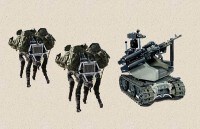Robot army invades Zenutia

Big Dog leads the charge while Taranis provides air cover
- Dateline
- 7 April 2016
It’s an open secret that NATO has been planning an invasion, but the ‘troops’ sent in to ‘restore democracy’ are quite unusual. For the first time in a conventional battle, no soldiers actually entered enemy territory.
It looks a lot like something out of Star Wars, with robotic vehicles, legged machines called Big Dogs and pilotless aircraft leading the attack.
The Commander sits well behind the front lines, directing the passage of war on his WarStation screen. You could easily confuse it with a PlayStation game – the screen and controls are identical.
The ground forces are all remotely controlled and un-manned droids, guided by constant feedback from spy satellites and webcam drones.
Even the stealth fighters and bombers are un-manned combat air vehicles or UCAVs. These robots are so sophisticated, they can defend themselves from enemy attack, and don’t need to be constantly ‘driven’ by remote control operators.
Putting machines in harm’s way instead of citizens has been on the US Army’s agenda for some time. Now they can operate with engineers and dispense with medics.
“It’s so much easier when you can plan a strike without casualties,” says General Cole. “Of course, that doesn’t apply to the enemy – surrender is their best option.”
Robots have been operating for years on the battlefield, but activists and humanitarian agencies are up in arms over using machines against human soldiers. Despite the uproar, military robots are here to stay.
ANALYSIS >> SYNTHESIS: How this scenario came to be
War of the Machines
It’s inevitable that advanced robotic technology will be used to avoid loss of life on the battlefield. Author Peter Singer claims robots on and above the battlefield are bringing about the most profound transformation of warfare since the advent of the atom bomb.
“These robotic systems are not only having a big effect on how this new type of warfare is fought, but they also have initiated a set of contentious arguments about the implications of using ever more autonomous and intelligent machines in battle. Moving soldiers out of harm’s way may save lives, but the growing use of robots also raises deep political, legal and ethical questions about the fundamental nature of warfare and whether these technologies could inadvertently make wars easier to start,” claims Singer.
A further caveat is the notion that terrorists could adapt household robots to make even more sophisticated improvised explosive devices (IEDs). As is often the case, the technology is not at fault – rather blame the uses to which people put the technology.
Like it or not, military robots are here to stay.
2007: Faceless Fighters
The US Joint Unmanned Combat Air System (a pilot-less fighter aircraft) begins active duty, “with integrated sensors, navigation and communications that can operate in the network-centric battlefield of tomorrow.” These stealth fighters can be controlled interactively by a special version of Microsoft Flight Simulator. The pilot experience is a lot like being in the training simulator, rather than the aircraft under enemy fire.
Future improvements will give the UCAS self-defense capability.
2009: Road Warriors
The US Autonomous Fighting Vehicle (essentially a driver-less tank) takes to the battlefield. With thermal imaging sensors and “intelligent mission control” software, these vehicles are launched on ‘seek and destroy’ missions without constant remote control. But when they run into difficulties, an alert is triggered and they can be driven by remote. On-board cameras provide a real-time view of the action.
2010: Border Guards
While Predator drones have been picking off selected targets in Afghanistan with surgical precision, Packbots are doing sterling duty defusing explosive devices.
Israel deploys SentryTech, a remotely operated camera/machine gun on its borders, while South Korea tests a similar rig in the demilitarized zone bordering North Korea.
Boston Dynamics’ BigDog robot is a big hit on YouTube, demonstrating a ‘spooky’ ability to keep its balance and navigate almost any terrain.
2012: LS3 Walks Out
The successor to BigDog, a sturdy, armoured leggy robot called LS3, walks out to do duty with US troops. Developed by Boston Dynamics with support from DARPA, LS3 can cover harsh terrain, carry large loads, and bring wounded soldiers safely back to base.
The British UCAV, Taranis is readied for test missions. The stealthy jet can carry a load of weapons and surveillance equipment to intercontinental destinations, without pilots. Taranis uses artificial intelligence to defend itself against attack, and to seek out and destroy its targets.
2016: Robot Armies
The opportunity has arrived. NATO Command sends in the first invasion force without any human soldiers. “Once the enemy defences have been neutralized by the drones and droids, the Peace Force can go in and take control,” says the General. “We expect zero casualties on our side.”
Links to related stories
- Taranis: The £143million unmanned stealth jet that will hit targets in another continent - Mail on Sunday, 13 July 2010
- Robots of War - video review
- Boston Dynamics Big Dog (YouTube video)
- Countries Look to Robot Armies for Border Defense - Aol News, 13 July 2010
- Terminate the Terminators -Scientific American magazine, July 2010
- MindBullet: US-LED COALITION INVADES IRAN (Dateline: 7 April 2013, Published: 16 December 2004)
- MindBullet: INSECT SOLDIER-BOTS DEFEAT HUMAN ARMY (Dateline: 28 April 2014, Published: 12 March 2009)
- MindBullet: US PRESIDENT ESCAPES SUICIDE ROBOT ATTACK (Dateline: 11 September 2011, Published: 13 March 2008)
Warning: Hazardous thinking at work
Despite appearances to the contrary, Futureworld cannot and does not predict the future. Our Mindbullets scenarios are fictitious and designed purely to explore possible futures, challenge and stimulate strategic thinking. Use these at your own risk. Any reference to actual people, entities or events is entirely allegorical. Copyright Futureworld International Limited. Reproduction or distribution permitted only with recognition of Copyright and the inclusion of this disclaimer.